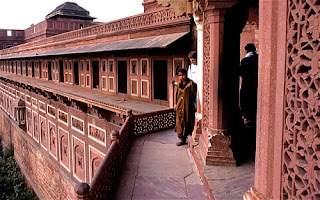Red Fort Complex
The Red Fort Complex was built as the palace fort of Shahjahanabad – the new capital of the fifth Mughal Emperor of India, Shah Jahan. Named for its massive enclosing walls of red sandstone, it is adjacent to an older fort, the Salimgarh, built by Islam Shah Suri in 1546, with which it forms the Red Fort Complex. The private apartments consist of a row of pavilions connected by a continuous water channel, known as the Nahr-i-Behisht (Stream of Paradise). The Red Fort is considered to represent the zenith of Mughal creativity which, under the Shah Jahan, was brought to a new level of refinement. The planning of the palace is based on Islamic prototypes, but each pavilion reveals architectural elements typical of Mughal building, reflecting a fusion of Persian, Timurid and Hindu traditions The Red Fort’s innovative planning and architectural style, including the garden design, strongly influenced later buildings and gardens in Rajasthan, Delhi, Agra and further afield.
Outstanding Universal Value
The planning and design of the Red Fort represents a culmination of architectural development initiated in 1526 AD by the first Mughal Emperor and brought to a splendid refinement by Shah Jahan with a fusion of traditions: Islamic, Persian, Timurid and Hindu. The innovative planning arrangements and architectural style of building components as well as garden design developed in the Red Fort strongly influenced later buildings and gardens in Rajasthan, Delhi, Agra and further afield. The Red Fort has been the setting for events which have had a critical impact on its geo-cultural region.
Criterion (ii): The final flourishing of Mughal architecture built upon local traditions but enlivened them with imported ideas, techniques, craftsmanship and designs to provide a fusion of Islamic, Persian, Timurid and Hindu traditions. The Red Fort demonstrates the outstanding results this achieved in planning and architecture.
Criterion (iii): The innovative planning arrangements and architectural style of building components and garden design developed in the Red Fort strongly influenced later buildings and gardens in Rajasthan, Delhi, Agra and further afield. The Red Fort Complex also reflects the phase of British military occupation, introducing new buildings and functions over the earlier Mughal structures.
Criterion (vi): The Red Fort has been a symbol of power since the reign of Shah Jahan, has witnessed the change in Indian history to British rule, and was the place where Indian independence was first celebrated, and is still celebrated today. The Red Fort Complex has thus been the setting of events critical to the shaping of regional identity, and which have had a wide impact on the geo-cultural region.
The Red Fort Complex is a layered expression of both Mughal architecture and planning, and the later British military use of the forts. The most dramatic impacts on the integrity of the Red Fort Complex come from the change of the river into a major road, which alters the relationship of the property to its intended setting; and from the division of the Salimgarh Fort by a railway. Nevertheless the Salimgarh Fort is inextricably linked to the Red Fort in use and later history. The integrity of the Salimgarh Fort can only be seen in terms of its value as part of the overall Red Fort Complex. The authenticity of the Mughal and British buildings in the Red Fort Complex is established, although more work is needed to establish the veracity of the current garden layout. In the specific case of the Salimgarh Fort, the authenticity of the Mughal period is related to knowledge of its use and associations, and of the built structures dating from the British period.
The nominated property has been declared a monument of national importance under the Ancient Monument and Archaeological Sites and Remains Act, 1959. A buffer zone has been established. Although the state of conservation of the property has improved over the past ten years, much more work is needed to put the overall state of the property into a stable condition and to ensure visitors do not contribute to its decay. The Red Fort Complex is managed directly by the Archaeological Survey of India, which is also responsible for the protection of all national level heritage sites in India and Indian cultural properties included in the World Heritage List.
Photo gallery.
Photo gallery.

























No comments:
Post a Comment